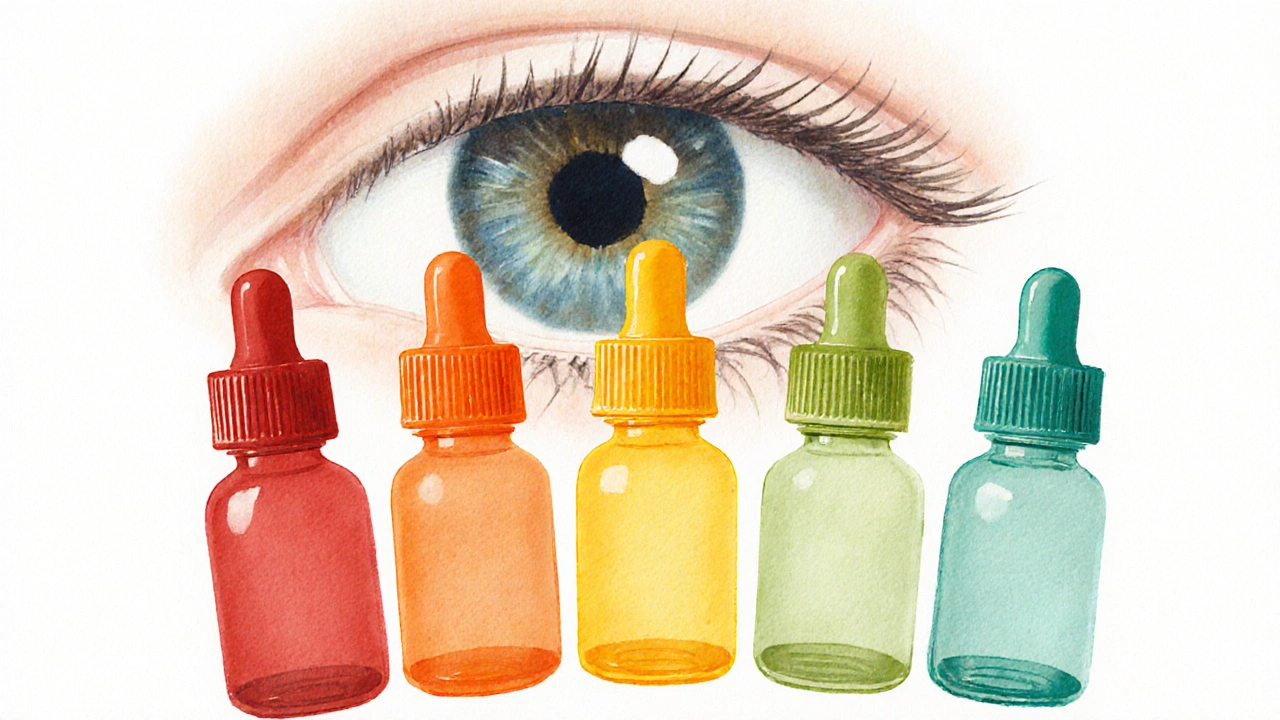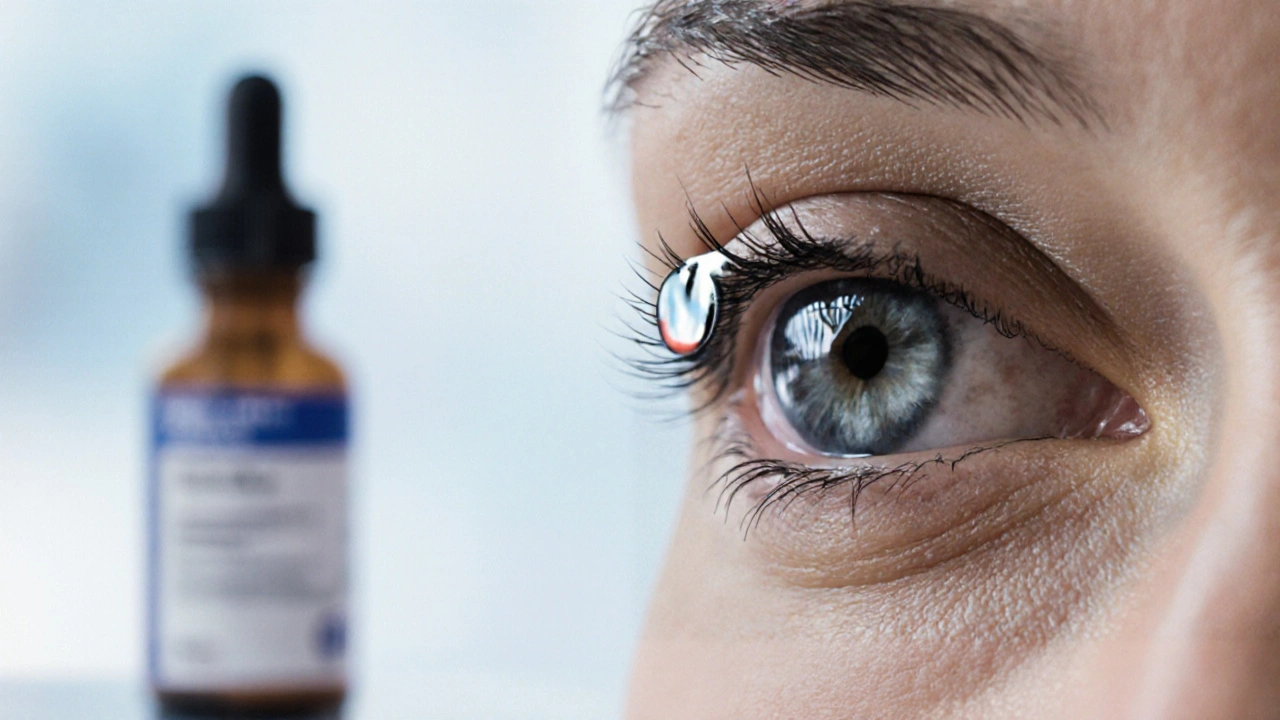Eye Steroid Selection Guide
Comparison Overview
FML Forte (Fluorometholone)
Medium PotencyUsed for post-surgical inflammation with moderate IOP risk.
Prednisolone Acetate
High PotencyFor severe inflammation but higher IOP risk.
Loteprednol Etabonate
Medium-Low PotencyLower IOP risk, quick breakdown in ocular tissue.
Dexamethasone
Very High PotencyIntense inflammation, high cost, high IOP risk.
Hydrocortisone
Low PotencyMild irritation, minimal IOP risk.
Quick Summary
- FML Forte is a medium‑potency corticosteroid used for post‑surgical eye inflammation.
- Key alternatives include prednisolone acetate, loteprednol etabonate, dexamethasone, and hydrocortisone.
- Potency, side‑effect profile, and cost differ markedly; choose based on inflammation severity and patient risk factors.
- Low‑potency steroids (hydrocortisone) are safest for mild allergic conjunctivitis, while high‑potency options (dexamethasone) suit aggressive post‑op cases.
- Always monitor intra‑ocular pressure and educate patients on proper drop technique.
What is FML Forte?
FML Forte is a brand‑name ophthalmic suspension containing 0.1% fluorometholone, a synthetic corticosteroid that reduces ocular inflammation by inhibiting cytokine production. Marketed primarily for post‑operative inflammation after cataract or LASIK surgery, it offers a balance between efficacy and a relatively low risk of raising intra‑ocular pressure (IOP). The drug is typically prescribed as one drop four times daily for the first week, tapering over 2‑3 weeks depending on the surgeon’s protocol.
Fluorometholone belongs to the class of corticosteroids but is considered medium‑potency compared with prednisolone (higher) or hydrocortisone (lower). Its chemical structure includes a fluorine atom that enhances anti‑inflammatory activity while slightly reducing mineralocorticoid effects, which translates into a modest IOP rise in most patients.
Main Alternatives on the Market
When doctors consider alternatives, they usually look at the same therapeutic goal-controlling inflammation-while balancing potency, side‑effects, cost, and dosing convenience. Below are the most common substitutes.
Prednisolone acetate
This is a high‑potency steroid (1% suspension) often used for severe inflammation such as uveitis or aggressive post‑op swelling. It has a faster onset than fluorometholone but carries a higher risk of IOP spikes, especially with prolonged use.
Loteprednol etabonate
Loteprednol is a “soft” steroid designed to break down quickly in ocular tissues, reducing long‑term side effects. Available as 0.5% drops (e.g., Lotemax), it offers comparable efficacy to prednisolone for many cases but with a markedly lower tendency to raise IOP.
Dexamethasone ophthalmic
Dexamethasone (0.1% or 0.125% solution) is a very high‑potency steroid frequently reserved for intense inflammation like postoperative endophthalmitis. Its strength makes it effective quickly, yet the price point and side‑effect risk are also the highest among topical steroids.
Hydrocortisone ophthalmic
Hydrocortisone 0.5% or 1% is the lowest‑potency steroid, mainly used for mild allergic conjunctivitis or superficial irritation. It rarely raises IOP, making it a safe first‑line option when inflammation is minimal.
Bromfenac ophthalmic
While not a steroid, bromfenac is a non‑steroidal anti‑inflammatory drug (NSAID) eye drop (0.09%) often paired with low‑potency steroids after cataract surgery to control pain and inflammation without adding steroid‑related side effects.

How They Stack Up - Comparison Table
| Brand / Generic | Potency | Typical Dose | Onset of Action | Common Side Effects | Average US Price (per bottle) |
|---|---|---|---|---|---|
| FML Forte (Fluorometholone) | Medium | 1 drop 4×/day, taper 2-3weeks | 12-24hrs | Mild IOP rise, temporary burning | $25-$30 |
| Prednisolone acetate | High | 1 drop 4-6×/day, taper 4-6weeks | 6-12hrs | IOP spikes, cataract progression | $15-$20 |
| Loteprednol etabonate | Medium‑low | 1 drop 4×/day, taper 2-4weeks | 12-18hrs | Very low IOP increase, mild irritation | $35-$45 |
| Dexamethasone | Very high | 1 drop 4×/day, short course (5‑7days) | Within 4-6hrs | Significant IOP rise, cataract risk | $20-$25 |
| Hydrocortisone | Low | 1 drop 3-4×/day, as needed | 24-48hrs | Rarely elevates IOP, possible stinging | $8-$12 |
Choosing the Right Eye Steroid - Practical Scenarios
Not every steroid fits every eye condition. Below are common clinical situations and the most suitable choice based on the table above.
- Post‑cataract or LASIK surgery with mild‑to‑moderate inflammation: FML Forte provides enough power without the high IOP risk of prednisolone.
- Severe uveitis or postoperative endophthalmitis: Prednisolone acetate or Dexamethasone are preferred for their rapid, strong anti‑inflammatory effect.
- Patients with glaucoma or steroid‑responsive IOP elevation: Loteprednol etabonate or low‑potency Hydrocortisone minimize pressure spikes.
- Allergic conjunctivitis with mild irritation: Hydrocortisone is often enough, avoiding unnecessary steroid strength.
- Patients who prefer non‑steroidal options or need pain control: Bromfenac can be combined with a low‑potency steroid to cover both pain and inflammation.
Practical Tips for Safe Use
- Always wash hands before instilling drops; avoid touching the bottle tip to the eye.
- Use a punctual schedule-most steroids work best when given at evenly spaced intervals.
- Check intra‑ocular pressure after 2‑4weeks of any medium‑ or high‑potency steroid, especially in glaucoma suspects.
- If vision blurs or a white cataract begins to develop, discontinue the steroid and consult an eye‑care professional.
- Store bottles at room temperature, keep caps tight; discard after the expiration date even if drops appear clear.
Frequently Asked Questions
How long can I safely use FML Forte?
Most surgeons advise a taper of 2-3weeks. If inflammation persists, a follow‑up exam is needed to decide whether to continue, switch, or stop.
Is there a risk of cataract formation with fluorometholone?
Long‑term high‑dose steroid use can accelerate cataract formation, but short post‑op courses of fluorometholone rarely cause this issue.
Can I switch from prednisolone acetate to FML Forte mid‑treatment?
Yes, many clinicians step down to a lower‑potency steroid once inflammation is under control. The switch should be done gradually to avoid rebound swelling.
What should I do if my eye feels gritty after using steroid drops?
A mild burning or gritty feeling is common. If it persists for more than a day or worsens, rinse the eye with sterile saline and contact your ophthalmologist.
Are generic versions of these steroids as effective as brand‑name drops?
Generic formulations contain the same active ingredient and concentration, so efficacy is comparable. However, preservative type and bottle design can affect tolerability for some patients.


Comments
Jo D
Wow, because a 0.1% fluorometholone droplet is basically the holy grail of ocular micro‑nano‑pharmaco‑dynamics, right?
On October 4, 2025 AT 02:50
Sinead McArdle
Thank you for the thorough overview. The comparison table is especially helpful for quickly assessing cost versus potency. I appreciate the clear layout and the practical tips on IOP monitoring.
On October 8, 2025 AT 17:57
Katherine Krucker Merkle
Nice summary! I’ve been using FML Forte after cataract surgery and found the taper schedule works well. It’s good to know there are lower‑risk options like loteprednol for patients with glaucoma.
On October 13, 2025 AT 09:03
Mark Quintana
I noticed the article mentions a 2‑3‑week taper for FML Forte, but in my practice we sometimes extend to four weeks if inflammation lingers. It’s worth mentioning that patient compliance can affect outcomes.
On October 18, 2025 AT 00:10
Max Canning
Hey folks, if you’re on the fence, give FML Forte a shot – it’s a solid middle‑ground that won’t scare your eye pressure up too fast. Plus, the price is pretty decent for what you get!
On October 22, 2025 AT 15:17
Nick Rogers
In summary, the selection of an ophthalmic steroid should be guided by inflammation severity, intra‑ocular pressure risk, and cost considerations; each agent presents a distinct risk‑benefit profile; clinicians must tailor therapy accordingly.
On October 27, 2025 AT 06:23
Tesia Hardy
Great info! Remember, patient education on proper drop technique can make a huge difference – clean hands, don’t touch the bottle tip, and follow the schedule diligently.
On October 31, 2025 AT 21:30
Michelle Guatato
Don’t be fooled by the pharma hype – they push high‑potency steroids like prednisolone to keep you hooked on expensive meds. The “medium” label on FML Forte is just a marketing ploy to sell more bottles.
On November 5, 2025 AT 12:37
Gabrielle Vézina
Actually the “low‑potency” label is misleading; hydrocortisone barely does anything for post‑op inflammation.
On November 10, 2025 AT 03:43
carl wadsworth
Listen up, everyone: if you’re dealing with a steroid‑responsive IOP rise, skip the high‑potency drops and go straight to loteprednol. It’s safe, effective, and saves you a trip back to the clinic.
On November 14, 2025 AT 18:50
Neeraj Agarwal
While the table is helpful, note that “prednisone” is misspelled; the correct term is “prednisolone”. Accuracy matters in medical writing.
On November 19, 2025 AT 09:57